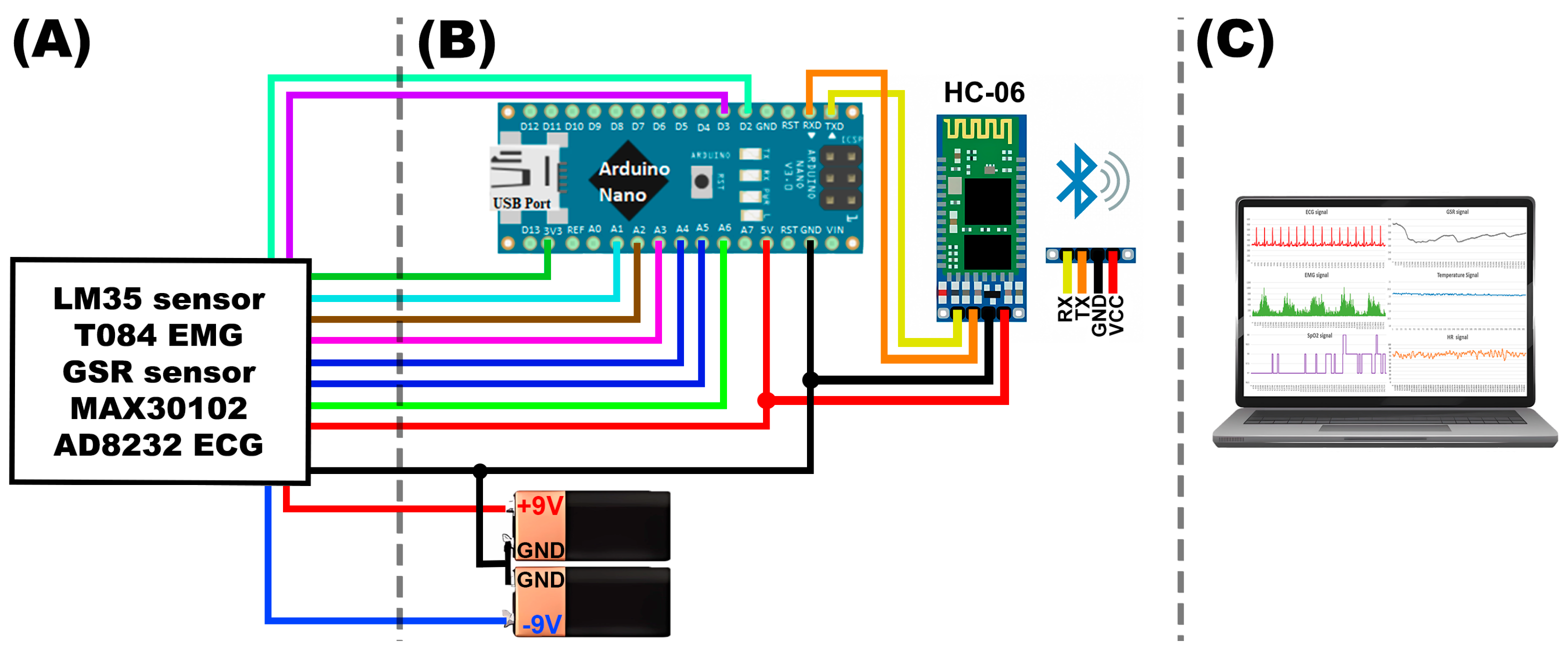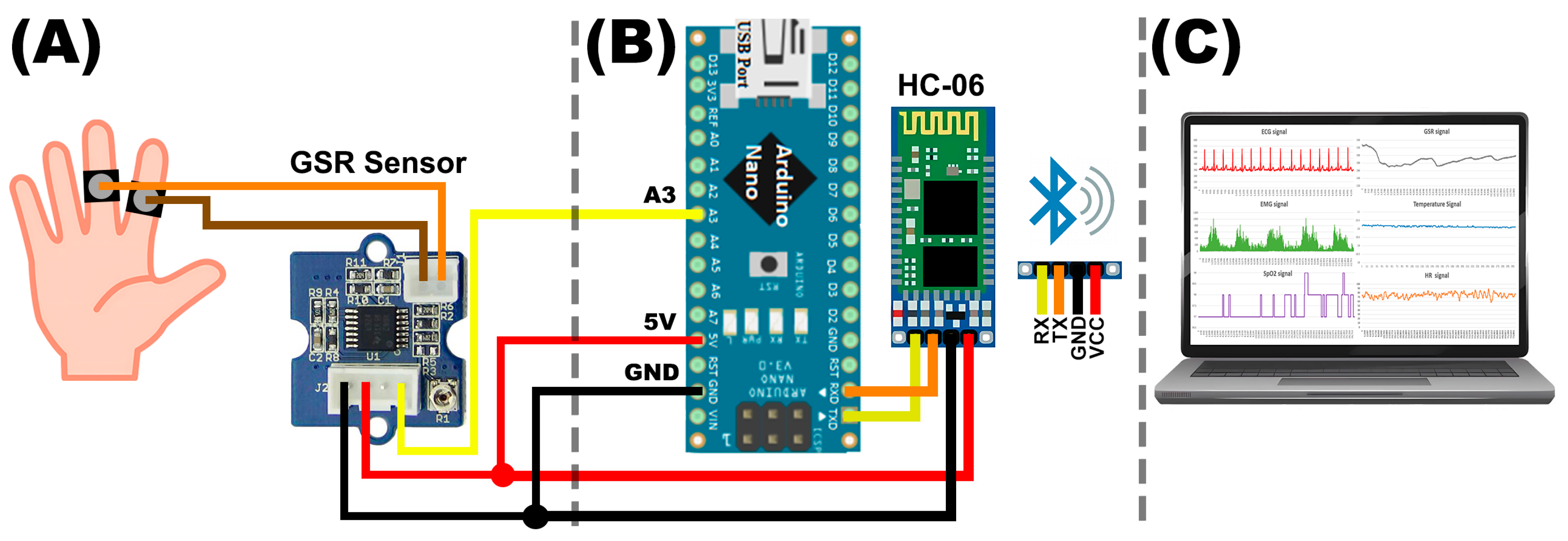Development of a Low-Cost Interactive Prototype for Acquisition and Visualization of Biosignals †
Abstract
:1. Introduction
2. Materials and Methods
2.1. Body Temperature LM35
2.2. AD8232 ECG Circuit
2.3. EMG Muscle T084 Board
2.4. MAX30102 Heart Rate Pulsioximeter
2.5. Grove GSR Sensor
2.6. Digital Stage Stability
3. Results
3.1. Biosignals Obtained from the Prototype
3.2. Digital Stage Stability
4. Discussion
5. Conclusions
Author Contributions
Funding
Institutional Review Board Statement
Informed Consent Statement
Data Availability Statement
Acknowledgments
Conflicts of Interest
References
- Global Challenge for Movement on Mental Health Kicks off as Lack of Investment in Mental Health Leaves Millions Without Access to Services. Available online: https://www.who.int/news/item/07-10-2020-global-challenge-for-movement-on-mental-health-kicks-off-as-lack-of-investment-in-mental-health-leaves-millions-without-access-to-services (accessed on 18 September 2024).
- Stress Effects on the Body. Available online: https://www.apa.org/topics/stress/body#:~:text=This+long-term+ong+oing+stress,tie+stress+to+heart+attack (accessed on 18 September 2024).
- Santomauro, D.F. Global prevalence and burden of depressive and anxiety disorders in 204 countries and territories in 2020 due to the COVID-19 pandemic. Lancet 2021, 398, 1700–1712. [Google Scholar] [CrossRef]
- Mendoza, F.; Valencia, A. Técnicas psicofisiológicas para evaluar el estrés en escenarios clínicos. In Estrés y Salud: Investigación Básica y Aplicada; Viveros, S., Ed.; El Manual Moderno: Mexico City, México, 2012; pp. 73–87. [Google Scholar]
- Giannakakis, G.; Grigoriadis, D.; Giannakaki, K.; Simantiraki, O.; Roniotis, A.; Tsiknakis, M. Review on psychological stress detection using biosignals. IEEE Trans. Affect. Comput. 2019, 13, 440–460. [Google Scholar] [CrossRef]
- Ahamed, M.A.; Ahad, M.A.-U.; Sohag, M.H.A.; Ahmad, M. Development of low cost wireless biosignal acquisition system for ECG EMG and EOG. In Proceedings of the 2015 2nd International Conference on Electrical Information and Communication Technologies (EICT), Khulna, Bangladesh, 10–12 December 2015. [Google Scholar] [CrossRef]
- Ahamed, M.A.; Asraf-Ul-Ahad, M.; Sohag, M.H.A.; Ahmad, M. Development of low cost wireless ECG data acquisition system. In Proceedings of the 2015 International Conference on Advances in Electrical Engineering (ICAEE), Dhaka, Bangladesh, 17–19 December 2015. [Google Scholar] [CrossRef]
- Bravo-Zanoguera, M.; Cuevas-González, D.; Reyna, M.A.; García-Vázquez, J.P.; Avitia, R.L. Fabricating a Portable ECG Device Using AD823X Analog Front-End Microchips and Open-Source Development Validation. Sensors 2020, 20, 5962. [Google Scholar] [CrossRef] [PubMed]
- Nie, J.; Liu, Y.; Hu, Y.; Wang, Y.; Xia, S.; Preindl, M.; Jiang, X. SPIDERS+: A Light-Weight, Wireless, and Low-Cost Glasses-Based Wearable Platform for Emotion Sensing and Bio-Signal Acquisition. Pervasive Mob. Comput. 2021, 75, 101424. [Google Scholar] [CrossRef]
- LM35 Precision Centigrade Temperature Sensors. Available online: https://www.ti.com/lit/ds/symlink/lm35.pdf (accessed on 18 September 2024).
- Single-Lead, Heart Rate Monitor Front End. Available online: https://www.analog.com/media/en/technical-documentation/data-sheets/ad8232.pdf (accessed on 18 September 2024).
- Ajdaraga, E.; Gusev, M. Analysis of sampling frequency and resolution in ECG signals. In Proceedings of the 2017 25th Telecommunication Forum (TELFOR), Belgrade, Serbia, 21–22 November 2017. [Google Scholar] [CrossRef]
- Three-lead Differential Muscle/Electromyography Sensor for Microcontroller Applications. Available online: https://www.pololu.com/file/0J745/Muscle_Sensor_v3_users_manual.pdf (accessed on 18 September 2024).
- Toledo-Pérez, D.C.; Rodríguez-Reséndiz, J.; Gómez-Loenzo, R.A.; Jauregui-Correa, J.C. Support Vector Machine-Based EMG Signal Classification Techniques: A Review. Appl. Sci. 2019, 9, 4402. [Google Scholar] [CrossRef]
- Bian, F.; Li, R.; Liang, P. SVM based simultaneous hand movements classification using sEMG signals. In Proceedings of the 2017 IEEE International Conference on Mechatronics and Automation (ICMA), Takamatsu, Japan, 6–9 August 2017. [Google Scholar] [CrossRef]
- High-Sensitivity Pulse Oximeter and Heart-Rate Sensor for Wearable Health. Available online: https://www.analog.com/media/en/technical-documentation/data-sheets/MAX30102.pdf (accessed on 18 September 2024).
- Burma, J.S.; Lapointe, A.P.; Soroush, A.; Oni, I.K.; Smirl, J.D.; Dunn, J.F. Insufficient Sampling Frequencies Skew Heart Rate Variability Estimates: Implications for Extracting Heart Rate Metrics from Neuroimaging and Physiological Data. J. Biomed. Inform. 2021, 123, 103934. [Google Scholar] [CrossRef]
- Zhang, X.; Zhang, Y.; Si, Y.; Gao, N.; Zhang, H.; Yang, H. A High Altitude Respiration and SpO2 Dataset for Assessing the Human Response to Hypoxia. Sci. Data 2024, 11, 248. [Google Scholar] [CrossRef] [PubMed]
- Reichelt, L.J.; Badiola, I.; Blazek, V.; Leonhardt, S.; Lüken, M. Development of a Ring-Shaped Pulse Oximeter to Analyse Angle Dependency in SpO2 Estimation. In Proceedings of the 51st international Computing in Cardiology conference, Karlsruhe, Germany, 8–11 September 2024. [Google Scholar]
- Grove—GSR. Available online: https://www.mouser.com/catalog/specsheets/Seeed_101020052.pdf (accessed on 18 September 2024).
- Galvanic Skin Response (GSR): The Complete Pocket Guide. Available online: https://imotions.com/blog/learning/research-fundamentals/galvanic-skin-response/#what-is-gsr-galvanic-skin-response (accessed on 18 September 2024).
- Amezquita Garcia, J.A. Aprendizaje automático en los movimientos de los dedos con visualización en Opensim y diseño inalámbrico para la portabilidad en la adquisición de señales de electromiografía. Doctoral Thesis, Universidad Autónoma de Baja California, Mexicali, Mexico, 2022. [Google Scholar]







Disclaimer/Publisher’s Note: The statements, opinions and data contained in all publications are solely those of the individual author(s) and contributor(s) and not of MDPI and/or the editor(s). MDPI and/or the editor(s) disclaim responsibility for any injury to people or property resulting from any ideas, methods, instructions or products referred to in the content. |
© 2024 by the authors. Licensee MDPI, Basel, Switzerland. This article is an open access article distributed under the terms and conditions of the Creative Commons Attribution (CC BY) license (https://creativecommons.org/licenses/by/4.0/).
Share and Cite
Delgado-Torres, J.C.; Cuevas-González, D.; Reyna, M.A.; García-Vázquez, J.P.; Altamira-Colado, E.; Sánchez-Barajas, M.A.; Barreras, O.E. Development of a Low-Cost Interactive Prototype for Acquisition and Visualization of Biosignals. Eng. Proc. 2024, 82, 1. https://doi.org/10.3390/ecsa-11-20444
Delgado-Torres JC, Cuevas-González D, Reyna MA, García-Vázquez JP, Altamira-Colado E, Sánchez-Barajas MA, Barreras OE. Development of a Low-Cost Interactive Prototype for Acquisition and Visualization of Biosignals. Engineering Proceedings. 2024; 82(1):1. https://doi.org/10.3390/ecsa-11-20444
Chicago/Turabian StyleDelgado-Torres, Juan C., Daniel Cuevas-González, Marco A. Reyna, Juan Pablo García-Vázquez, Eladio Altamira-Colado, Martín Aarón Sánchez-Barajas, and Oscar E. Barreras. 2024. "Development of a Low-Cost Interactive Prototype for Acquisition and Visualization of Biosignals" Engineering Proceedings 82, no. 1: 1. https://doi.org/10.3390/ecsa-11-20444
APA StyleDelgado-Torres, J. C., Cuevas-González, D., Reyna, M. A., García-Vázquez, J. P., Altamira-Colado, E., Sánchez-Barajas, M. A., & Barreras, O. E. (2024). Development of a Low-Cost Interactive Prototype for Acquisition and Visualization of Biosignals. Engineering Proceedings, 82(1), 1. https://doi.org/10.3390/ecsa-11-20444







